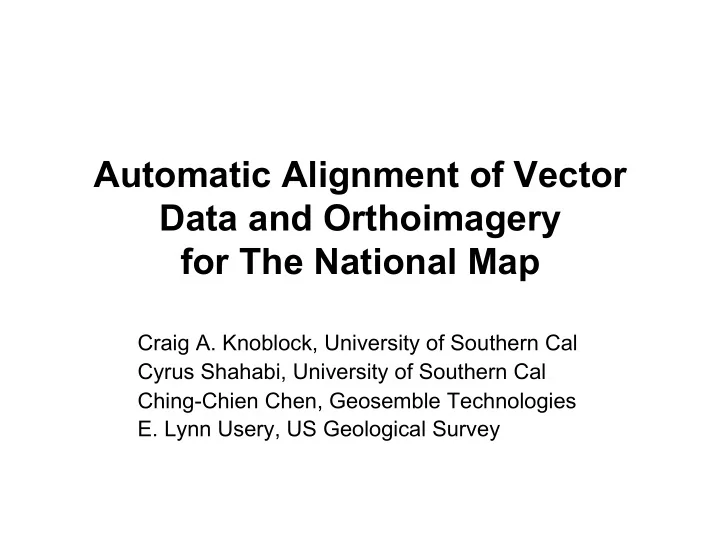

Automatic Alignment of Vector Data and Orthoimagery for The National Map Craig A. Knoblock, University of Southern Cal Cyrus Shahabi, University of Southern Cal Ching-Chien Chen, Geosemble Technologies E. Lynn Usery, US Geological Survey
Outline • Introduction & Motivation – The National Map • Our Approach to align vector and imagery – Approach overview – Improvements over our previous approach • Related Work • Conclusion and Future Work
Introduction • Geospatial data sources have become widely available • Automatically and accurately integrating and aligning two spatial datasets is a challenging problem Street maps Road network Orthoimagery ( in raster format ) ( in vector format ) ( in raster format )
Motivation: Vector and Imagery Integration � Challenges � Different projections, accuracy levels, resolutions result in spatial inconsistencies Lat / Long Lat / Long Lat / Long Lat / Long
Motivation: The National Map • The National Map is a government effort to make geospatial data available for 133 urban areas of the US for Homeland Security • Purpose is to make these integrated datasets available to government organizations to support crisis response and emergency planning, etc. • There are no automated techniques for aligning vector data with orthoimagery and this is a very labor intensive task.
Motivation: The state of the art • Traditionally, the problems of vector-imagery and map-imagery alignment have been in the domain of GIS and Computer Vision • In GIS literature – The alignments were previously performed manually • Commercial products: ESEA MapMerger ESRI ArcView; Able R2V ; Intergraph I/RASC • In Computer Vision literature – Alignment was performed automatically based on image processing techniques • Often required significant CPU time • Accuracy quite poor
Road network The example • The Data Sets (for the National Map) – USGS high resolution color imagery – Road vector data from DOT, MO USGS 0.3m/p color imagery They are misaligned, and there is no global transformation
The Vector-Imagery conflation approach Lat / Long Triangulation and Filtering Rubber-Sheeting Technique Final control points Intermediate control points Control Point Detection Lat / Long Lat / Long Lat / Long
Finding Control Points Using Localized Template Matching Learned color distribution for road/off road pixels Road classification road width and road directions Matching by Correlation road width and road directions
Finding Control Points Using Localized Template Matching Learned color distribution for road/off road pixels Road classification road width and road directions Matching by Correlation road width and road directions
Finding Control Points Using Localized Template Matching Learned color distribution for road/off road pixels Road classification road width and road directions Matching by Correlation road width and road directions
Finding Control Points Using Localized Template Matching Learned color distribution for road/off road pixels Road classification road width and road directions Matching by Correlation road width and road directions
Finding Control Points Using Localized Template Matching Learned color distribution for road/off road pixels Road classification road width and road directions Matching by Correlation road width and road directions
Filtering Control Points Using Vector Median Filter (VMF) – View the control point pair displacement as vector – Using a fixed ratio ( k %) to keep control point pairs that have similar displacement as the median one Y (meter) k% control-point vector Vector median 10 X (meter) -10 10 -10
Results: NAVSTREETS + High-res Image Original Conflated NAVSTREETS NAVSTREETS Completeness 44.9 % 74.4 % Correctness 47.9 % 85 % Positional Accuracy
Road Classification Used in Localized Template Matching • Before: Bayes classifier based on Hue component of learned road/off- road pixels • Improved: Support Vector Machine (SVM) classifier based on all color channels (R,G,B) of learned road/off-road pixels – Much fewer “false positives” and more “true positives” Road-classified pixels Road-classified pixels Original imagery based on SVM classifier based on Bayes classifier
Filtering Control Points Using Vector Median Filter (VMF) • Improved: Dynamic determine the ratio – Investigate the cluster around the Y (meter) median vector Kept control-point vector (clustered vectors – Accommodate more control point pairs around the median vector) Most of the vectors are close to the median vector. Vector median This forms a cluster around the median vector 10 X (meter) -10 10 -10
The Vector-Imagery conflation approach: Triangulation and RubberSheeting
The Vector-Imagery conflation approach: Triangulation and RubberSheeting
The Vector-Imagery conflation approach: Triangulation and RubberSheeting
Improved results: comparing with results based on previous technique Red lines: Original roads Yellow lines: Conflated results based on previous technique Blue lines: Conflated results based on improved technique
More improved results: comparing with results based on previous technique
Related Work • Vector to imagery conflation – Utilizing matched polygons [Hild et al. 98] – Utilizing matched lines [Filin et al. 00] – Utilizing matched junction-points [Flavie et al. 00] – All above solutions • Require lots of CPU time • Utilize vector data only for verifying detected features not for extracting features – Commercial products: ESRI AreView • Pick control points manually
Conclusion • Accomplishments Refinement of pattern recognition procedures for identifying the road intersections in the images Refinement of the filtering procedures for the ground control points Development of methods for matching across image panels Overall improvement of the accuracy of the transformed transportation data to match the images
Future Work • Address the alignment of road vector data with highways • Apply the same techniques to automatically align: – Vector Parcel Data – Hydrographic Data – Elevation Data
Recommend
More recommend